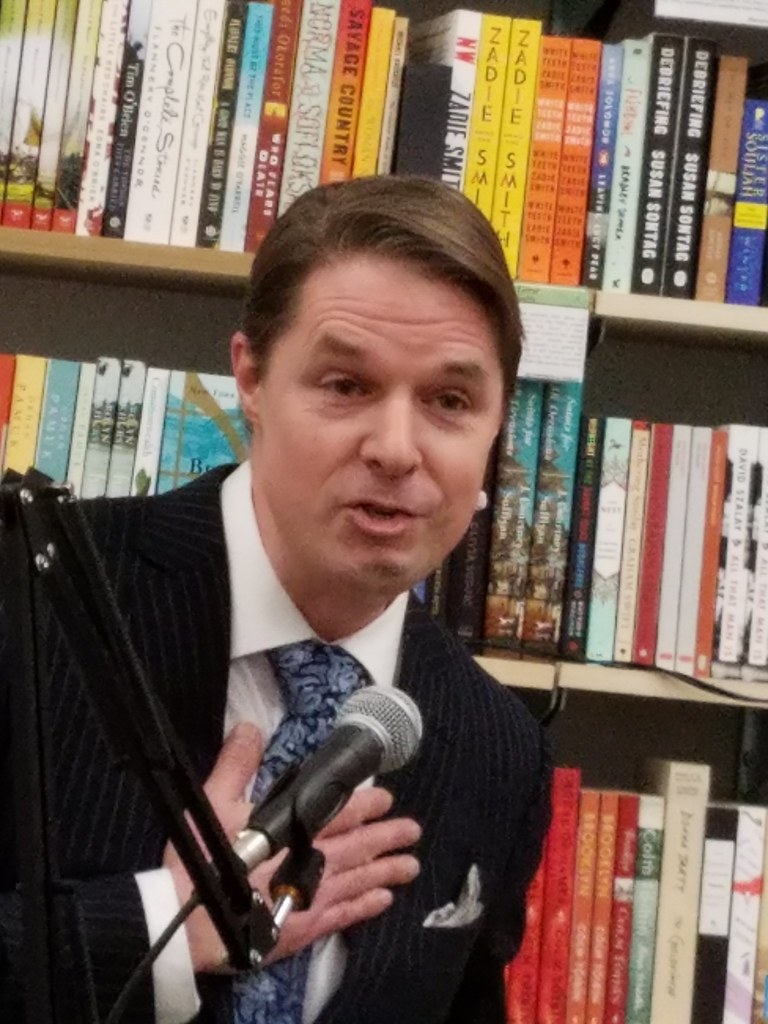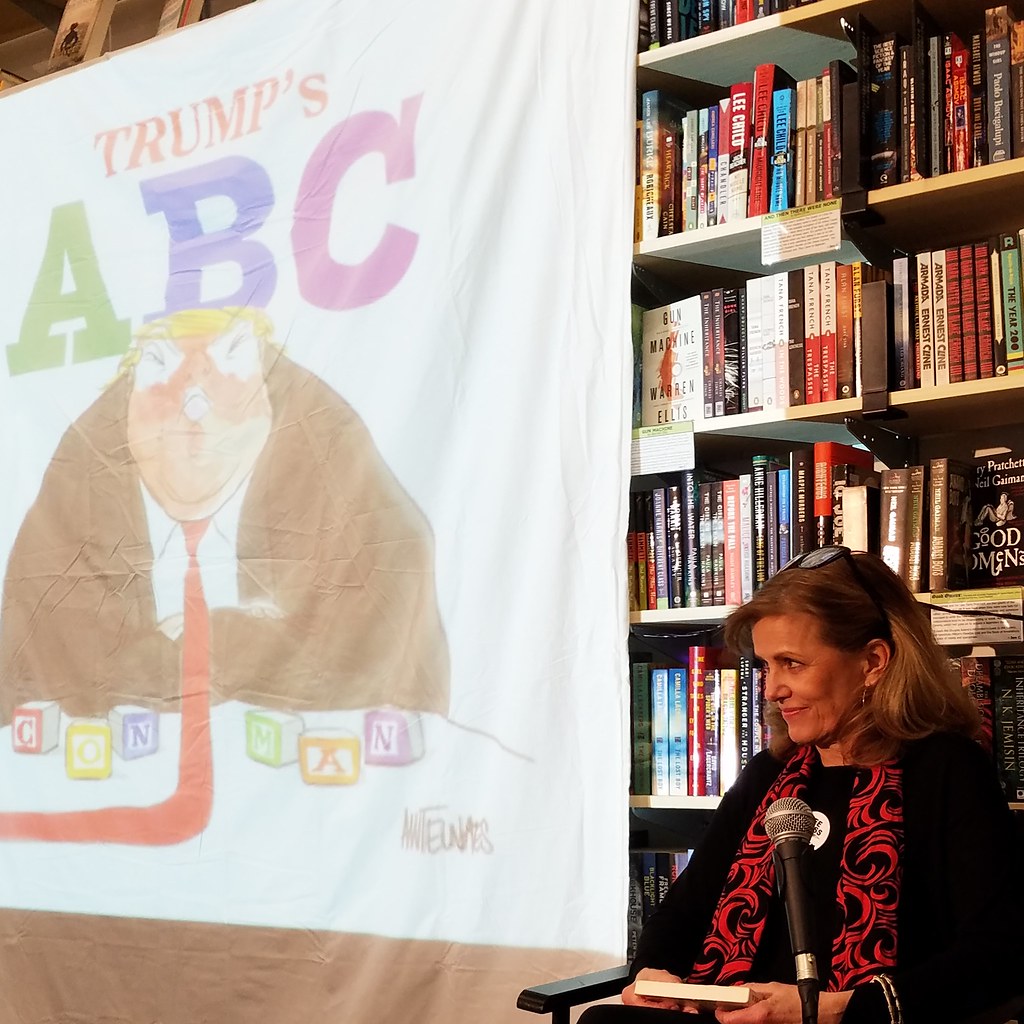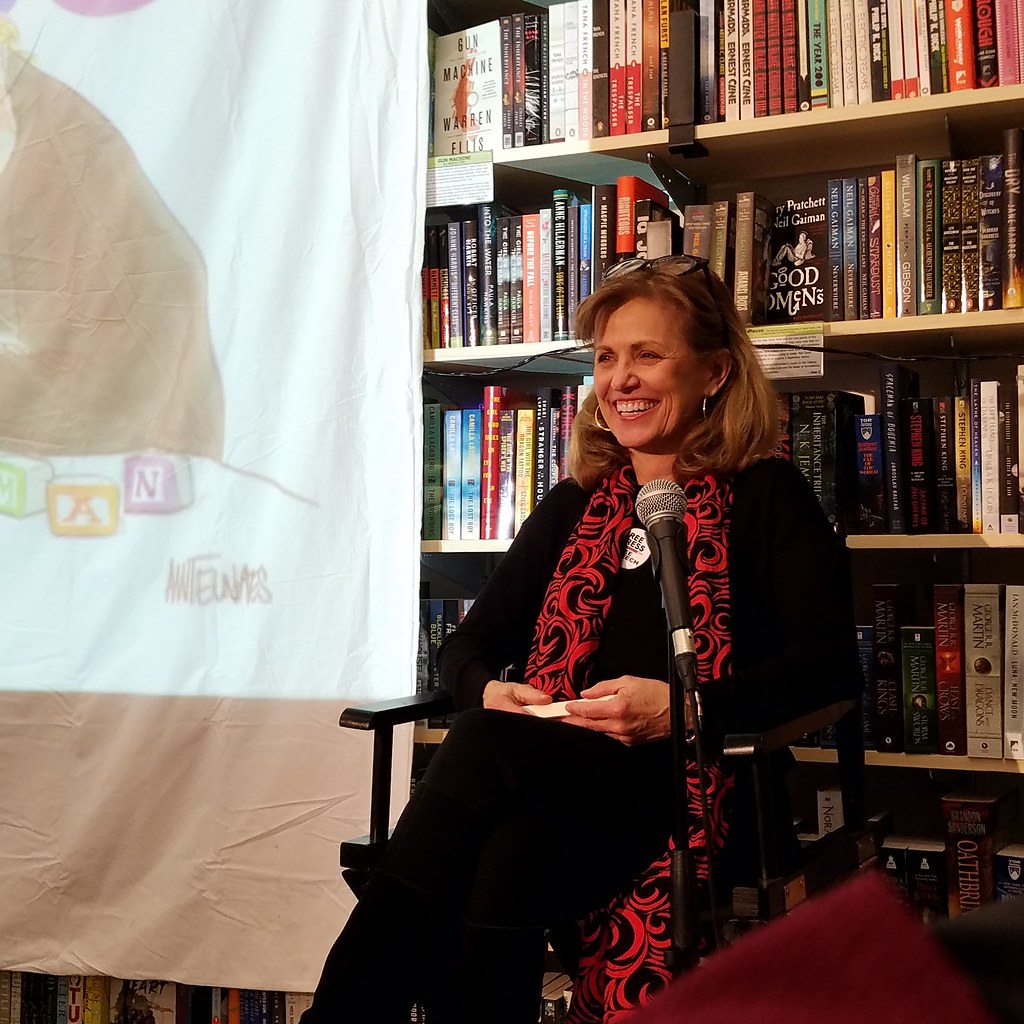Ross Maloy's life was "normal" until he discovered a lump over his right eye. Now he's navigating seventh grade with a terrifying cancer diagnosis—and a cowboy hat to keep UV rays off his face. As he tries to deflect some classmates' well-meaning yet exhausting pity and others' cruel memes, he finds an outlet in music. With his old best friend and an unlikely new one, Ross channels his rage into this thrilling new language. Inspired by the author's life, this empathetic and absolutely uproarious novel will resonate with anyone who has ever questioned the value of blending in. Ages 9-12.
Wednesday, July 08, 2020
Politics and Prose sessions with Tom Angleberger, Breena Bard, Maria Scrivan, and Rob Harrell
Ross Maloy's life was "normal" until he discovered a lump over his right eye. Now he's navigating seventh grade with a terrifying cancer diagnosis—and a cowboy hat to keep UV rays off his face. As he tries to deflect some classmates' well-meaning yet exhausting pity and others' cruel memes, he finds an outlet in music. With his old best friend and an unlikely new one, Ross channels his rage into this thrilling new language. Inspired by the author's life, this empathetic and absolutely uproarious novel will resonate with anyone who has ever questioned the value of blending in. Ages 9-12.
Saturday, July 13, 2019
Mother May I? at Politics & Prose!!! Today, 1 pm!
Friday, February 22, 2019
March 9: Jaime Hernandez - Is This How You See Me? in conversation with Sarah Boxer
Jaime Hernandez - Is This How You See Me? in conversation with Sarah Boxer
With his brothers Gilbert and Mario, Jaime Hernandez created Love and Rockets, one of the first comics to appear in the 1980s alternative comics movement. Hernandez has continued and expanded that series with his award-winning Locas narrative, chronicling the lives of a group of Latinas from their teenage years to today. Following 2014's Love Bunglers, the latest installment gathers all the Locas work Hernandez has published serially over the last four years, tracking the story of Maggie and Hopey as they make a pilgrimage back to their old neighborhood, relive the early days of their relationship, and re-experience several decades worth of exuberance and heartbreak. Hernandez will be in conversation with Sarah Boxer, cartoonist and critic with pieces in The New York Times, The Atlantic, and more. Hernandez will be in conversation with Sarah Boxer, cartoonist and critic with pieces in The New York Times, The Atlantic, and more.
Click here for more information.
Sunday, February 25, 2018
Tim Kreider Q&A: "I’m frankly glad to not be a political cartoonist right now"
 transcribed and edited by Mike Rhode
transcribed and edited by Mike Rhode Yeah, there’s a lot of that. I don’t even know how this book got written. I barely even remember doing any writing. There was always a lot of time feeling anxious and guilty. Writing a book is a marathon, rather than a sprint. I don’t know how interesting this is, but I made some rules for myself. I decided I had to have an office, so I went to the vast, ornate reading room of the New York City Public Library at 42nd St. to write my first book. It’s good to not do your work in exactly the same chair in front of exactly the same laptop where you email and watch Netflix and goof off. You have do to it on a regular schedule.
Yeah, there’s a lot of that. I don’t even know how this book got written. I barely even remember doing any writing. There was always a lot of time feeling anxious and guilty. Writing a book is a marathon, rather than a sprint. I don’t know how interesting this is, but I made some rules for myself. I decided I had to have an office, so I went to the vast, ornate reading room of the New York City Public Library at 42nd St. to write my first book. It’s good to not do your work in exactly the same chair in front of exactly the same laptop where you email and watch Netflix and goof off. You have do to it on a regular schedule. AM: I think the last time you were in town [for a book event], you were still cartooning for the Baltimore City Paper, so I was wondering where and what you’re teaching.
 TK: I think it might be really hard… so, no. This was hard. 200 pages – it took me five years! I don’t know what idea would sustain me through that much concentration, that much focus, and that much labor. I admire the epigrams of Nietzsche. I think if you can say something in a sentence, why take a paragraph; if you can do it in a paragraph, why take an essay; and if you can do it in an essay, why take a book? There’s a nice book by Antoine de Saint-Exupéry, who wrote The Little Prince, but also wrote a great book on aviation, Wind, Sand and Stars. I’m going to paraphrase, but he’s ostensibly talking about airplanes, but you know he’s talking about writing when he says, “Somethings attain their perfection not when nothing more can be added, but when nothing more can be taken away.” I admire concision and elegance in writing, so it would have to be a subject I felt required a book. It’s hard enough just writing an essay. Some of these essays are just one year and thirty pages long and it took me years. I don’t know what would possess me to that extent, unless I got sent into space... which is what I’m angling for.
TK: I think it might be really hard… so, no. This was hard. 200 pages – it took me five years! I don’t know what idea would sustain me through that much concentration, that much focus, and that much labor. I admire the epigrams of Nietzsche. I think if you can say something in a sentence, why take a paragraph; if you can do it in a paragraph, why take an essay; and if you can do it in an essay, why take a book? There’s a nice book by Antoine de Saint-Exupéry, who wrote The Little Prince, but also wrote a great book on aviation, Wind, Sand and Stars. I’m going to paraphrase, but he’s ostensibly talking about airplanes, but you know he’s talking about writing when he says, “Somethings attain their perfection not when nothing more can be added, but when nothing more can be taken away.” I admire concision and elegance in writing, so it would have to be a subject I felt required a book. It’s hard enough just writing an essay. Some of these essays are just one year and thirty pages long and it took me years. I don’t know what would possess me to that extent, unless I got sent into space... which is what I’m angling for.Friday, February 09, 2018
Review: Adrian Tomine's Killing and Dying
 by Mike Rhode
by Mike Rhode If I had to come up with a quick descriptive word for Adrien Tomine's work (and I just did), I think I'd pick "astringent." Tomine's a master of a cool thin line with a flat color palette, and his stories are often about people you'd prefer to avoid IRL. Tomine will be in town at Politics and Prose talking with Linda Holmes about Killing and Dying, his 2015 collection of his Optic Nerve comic book now available in paperback.
I'm reviewing the book now, even thought I bought it at 2015 at the Small Press Expo, because Drawn & Quarterly sent me a comp copy, and I don't want them to think it was unappreciated. Also, because in spite of my description above, I like his work. There are six stories in the book, all obviously by Tomine, but all different from each other as well.
Tomine is one of the group of formerly alternative 1980's cartoonists such as Daniel Clowes and Chris Ware who've hit the big time, and whose work is now instantly recognizable, as they're doing regular covers for the New Yorker and publishing graphic novel collections on a regular basis. This is a far cry from when they all were part of the small press scene being published in 'floppies' by Fantagaphics Books. Amazingly, those who've stayed in the field have largely remained true to the aesthetic they developed in their early works.
Tomine's first story, "...Horticusculpture" is purposely constrained to appear to be a weekly comic strip telling the story of a man growing old while attempting to convince the world that his new plant/sculpture hybrid is art. Six "strips" in black & white mimic a daily, while the full page Sunday is in color. Someone more academically-minded could theorize about the appeal of old-fashioned comic strips for alternative comic book cartoonists; among others, Daniel Clowes did a whole book using this motif, as did Bob Sikoryak who cast his net of influences a bit wider in his book on Apple. In the end, Tomine's story is about a man who's largely a failure personally and professionally, but is redeemed in the very last panel by his family's love.
"Amber Sweet" is a story of a modern-day mistaken identity in that a college student is a doppleganger for a porn actress. This coincidence ruins her life until the two of them finally meet. "Go Owls" is a cautionary tale which of a woman letting a man assume control over her life under the guise of protecting her. "Translated, from the Japanese" could easily have appeared in the New Yorker. No people are shown in the story, just scenes from traveling on plane, but again it's another story about human loneliness and failure in relationships.
Local cartoonist Dana Maier told me yesterday that "Killing and Dying" is her favorite story in the book, but I had to dash off before we discussed it. We may have that conversation here, if I can convince her to. A part of another dysfunctional family, a teenage girl wants to try standup comedy, and her mother agrees while her father thinks it's a mistake. Tomine has put several twists in the story, so that's all I'll reveal. Finally, "Intruders" is from the point of view of a failed veteran who breaks into the apartment he used to live in during the day, attempting to recapture his happier past, while providing no trace of himself in the present.
Tomine's cool, cerebral stories won't be to everyone's taste, but they're definitely worth sampling and this is a good collection to start with. He's grown to be an assured artist and writer, and will continue to be part of the graphic novel 'canon' for years to come.
---
Thursday, January 25, 2018
Ann Telnaes Q&A at Politics and Prose
 After she read Trump's ABC, her new book of caricatures about the administration, Ann Telnaes took questions from the audience for about thirty minutes. With her permission, I've transcribed them.
After she read Trump's ABC, her new book of caricatures about the administration, Ann Telnaes took questions from the audience for about thirty minutes. With her permission, I've transcribed them.  I put it aside and I happened to take a road trip down to Savannah during the holidays. I had a nine hour drive down and a nine hour drive back. I was driving, because my dog doesn’t, and I didn’t have my hands free to do any sketches. I was thinking about a suggestion a friend had given me, which was to do a political ABC book. Since my hands weren’t free, I put my phone on, and started to recite, “A is for blah, B is for blah...” and I kept doing that all the way down to Savannah and all the way back up. By the time I got back to D.C. I had a book.
I put it aside and I happened to take a road trip down to Savannah during the holidays. I had a nine hour drive down and a nine hour drive back. I was driving, because my dog doesn’t, and I didn’t have my hands free to do any sketches. I was thinking about a suggestion a friend had given me, which was to do a political ABC book. Since my hands weren’t free, I put my phone on, and started to recite, “A is for blah, B is for blah...” and I kept doing that all the way down to Savannah and all the way back up. By the time I got back to D.C. I had a book.  Oh god. You’re right. The only thing I find wanting in this book is that there’s other things I want to address. Maybe I can do a counting book.
Oh god. You’re right. The only thing I find wanting in this book is that there’s other things I want to address. Maybe I can do a counting book. Q: Since Trump is famously thin-skinned, do you know to what extent he has objected to your cartoons?
Q: Since Trump is famously thin-skinned, do you know to what extent he has objected to your cartoons? I think it’s going to go on for a while. I really do. There was a short time right after he became president where I thought “Maybe this is going to be over quickly.” The problem is, and this is what I do my most critical cartoons on, the Republican leadership is the enablers. They are the reason we are still at this point. They have decided that they are going to keep this man in office as long as he is useful to them. And unfortunately, I think that the way Trump operates, and what he responds to, and what he wants out of this… it’s going to be a back-and-forth situation. We’re just going to have to roll along with it. Unfortunately, I think it’s going to take a while.
I think it’s going to go on for a while. I really do. There was a short time right after he became president where I thought “Maybe this is going to be over quickly.” The problem is, and this is what I do my most critical cartoons on, the Republican leadership is the enablers. They are the reason we are still at this point. They have decided that they are going to keep this man in office as long as he is useful to them. And unfortunately, I think that the way Trump operates, and what he responds to, and what he wants out of this… it’s going to be a back-and-forth situation. We’re just going to have to roll along with it. Unfortunately, I think it’s going to take a while.More pictures from the evening can be seen at Bruce Guthrie's site. If you want to see how large her drawings are, original cartoons by Ann can be seen at the Library of Congress in the Drawn to Purpose exhibit or in the Hay-Adams Hotel's Off the Record bar. An article about the bar and the cartoonists (that I wrote and interviewed Ann for) will be in the upcoming issue of White House History magazine. Ann's previous book, Dick, about Vice President Cheney can be bought online and is highly recommended. Three styles of t-shirts with Ann's cartoons on them can be bought at Amazon.
Thursday, December 01, 2016
Juana Medina window display at Politics and Prose
A Winter Wonderland at P&P

Politics & Prose Bookstore and Coffeehouse
(5015 Connecticut Ave. NW)

Bruce Guthrie stopped by and took some photographs this afternoon. Click through to see more.
Friday, September 23, 2016
Sept 26: Jeffrey Brown and Judd Winick in Takoma Park
In Winick’s sequel to Hilo, the titular heroic alien robot unexpectedly returns to Earth and human friends DJ and Gina. Then, mysterious portals pop up all over town and disgorge one terrifying creature after another. An enormous mutant chicken and a million killer vegetables are only some of the foes that Hilo, DJ, and Gina must confront in order to save their community. Ages 9-12
Monday, October 19, 2015
Liniers today at Politics and Prose at 10:30 am
I saw Argentine cartoonist Ricardo Liniers last night. He was really entertaining and a sweet guy. He did a painting on stage, Michael Cavna interviewed him, he did some more painting and then signed books. His comic strip Macanudo is a big success in Latin America, and is now appearing in books in English. He's also done 2 books for younger readers with Toon Books. All three should be available at the bookstore today. He does a nice drawing in each book.
 You can see more see pictures at https://www.flickr.com/photos/42072348@N00/albums/72157659990511236
You can see more see pictures at https://www.flickr.com/photos/42072348@N00/albums/72157659990511236He's done 3 New Yorker magazine covers:
http://www.newyorker.com/culture/culture-desk/cover-story-obamas-elephant-problem
http://www.newyorker.com/uncategorized/cover-story-straphangers-by-liniers
http://www.newyorker.com/culture/culture-desk/cover-story-2015-03-16\
He also did one very crazy thing with one of his books. He printed Macanudo #6 (only in Spanish now) with a blank cover and drew an individual cover for each of the 5,000 in the first print run.
Here's one he did for me last night.







